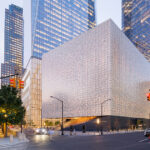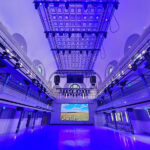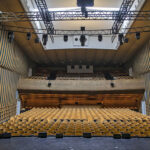A Historic Clock Tower Is Lit Using Modern Methods.
Dr. Emmet Brown: Don’t worry! As long as you hit that wire with the connecting hook at precisely eighty-eight miles per hour the instant the lightning strikes the tower, everything will be fine!
In the climax of the movie Back to the Future, Doc Brown and Marty McFly attach a steel cable to the town’s clock tower in order to harness the electricity of a pre-destined lightning strike. They then proceed to mispronounce the word “gigawatt,” and send Martyback to the future.
In a neighborhood near to Chicago’s Wrigley Field, another clock tower is lit up — without the need for a time machine or a guy named Biff.
10 Years Into the Past
In 1996, the condominium conversion of three historic industrial buildings was completed. The site had played host to a variety of companies in the past, including a stint as the headquarters of Bell & Howell.
At the time of their original construction, it was common to install water towers on the roofs of buildings to provide adequate water pressure to the tenants. In some cases, clocks were installed as facades for the otherwise unattractive water towers.
Brian Norkett, one of the new residents of the complex (recently re-dubbed “Larchmont Lofts”), noticed that the clock faces of the newly renovated building were not working. The developer promised the future repair of the clock mechanisms, then later reneged, eventually forcing Norkett and the condo association to pursue the issue in the Cook County court system.
After eight years of litigation, the developer eventually settled in 2006. Shortly thereafter, Norkett and the condominium association began the process of refurbishing the historic clock face.
8 Months Into the Past
A tuck pointer was hired to clean the terra cotta face and re-paint the clock’s numerals. A company was brought in from Cincinnati to gut the mechanical clock apparatus, replacing it with a modern-day digital mechanism that would be more accurate and automatically adjust for daylight savings.
Norkett said, “We also decided that we should light up the clock tower, and thereby allow it to serve as a night beacon for the Ravenwood and Lakeview neighborhoods. This was quite a technical challenge because the clock was never lit previously, and it was not designed to be back-lit through a translucent membrane as most lit clock towers are.”
The condo association initially contacted Scott Shelberg at Evergeen Oak/Crest Lighting, who subsequently referred the client to Lightswitch Chicago. Avraham “Avi” Mor, a lighting designer with Lightswitch, took the reins from there.
“We started talking about some different methods for lighting the clock face,” says Mor. “We looked at how big it is, and how impossible it is to reach the clock face, and that it could not be back-illuminated because it’s solid stone.”
Future maintenance was a key aspect of the design. Norkett noted that the height of the structure posed its own issues. “The fact that the face is nine stories — over 135 feet — in the air means it would be difficult to change bulbs and otherwise maintain any light fixtures which we might install on the face. We kind of threw some design ideas around in the office,” added Mor. “We came up with this idea of lighting it from a ring around the clock face.
“The really nice thing about it is that there’s no extraneous light that goes into the sky, and you don’t get the shadows from the clock hands. Any flood lighting would have created a shadow on the face of the clock. So, it actually turned out to be an ingenious idea. And, as we investigated it further, we said ‘why not light it with fiber?’”
12 Weeks Into the Past
“And that,” says Mor, “is when we turned to Fiber Optic Studio.”
Fiber Optic Studio is a specialty lighting firm based out of Winnetka, Ill. Working with LED and fiber optic technologies, they specialize in the creation of custom lighting solutions for their clients. Jenny Shulkin, the project manager for Fiber Optic Studio on this project, discussed the reasons for the fiber optic solution that was eventually implemented.
“Avi wanted some sort of solution — not even like an LED that would last five or ten years — but something that would essentially be a permanent solution. From his design standpoint, I think it was ‘how am I going to illuminate this clock tower so the owners never have to get up to the exterior again?’
“So, we went with fiber because we could plant all of the electrical work and all of the lighting inside the clock tower, and then pump that light outside through the fiber. We went through all of the visual design steps with the client. I know there was a big question in our design phase whether or not we were going to do color or if it was going to be a white light.”
With the condo board and the design team deciding on a strictly white light solution, it was time to move on to the engineering phase of the project.
60 Days Into the Past
“We decided to use a solid-core fiber that’s about an inch in diameter,” says Shulkin. “We put that inside of a metal channel that was maybe an inch or two larger than the clock itself, which had a nine-foot diameter.”
Mor commented that “On the coldest day of the summer — wearing shorts and a t-shirt because I thought it was a nice summer day — we went up on the rooftop and mocked up a piece of this fiber. It was really impressive!”
“We ended up having a U-channel bent into a ring,” says Shulkin, “with a fiber on the back side of it, facing the wall.”
Building code required that the stainless steel pieces be attached in such a way that they could withstand 100 mile-per-hour winds.
“The fiber sits in a custom stainless steel extrusion, which allows it to stand off from the building, as well as blocking extraneous light from lighting other surfaces of the clock face,” adds Mor.
Each of the four clock faces is ringed with a single piece of solid core fiber. On each face the fiber is routed to the exterior at the twelve o’clock position, lies inside of the channel around the clock, and re-enters the structure again at high noon.
Visual Lighting Technology supplied the 150-watt metal halide illuminators that feed both ends of each fiber. Four pieces of fiber and eight illuminators were installed in the clock tower.
“Metal halides are great because they’re super bright and they last,” says Shulkin. “That’s generally what works best on the sidelit fiber. Anything halogen really wouldn’t have thrown any light off.
“On one side of the fiber it has a white coating. If you’re working with a thirty-foot strand, it has more etchings in it near the end than at the beginning so that the light stays consistent. At the beginning you might have an etch every three or four inches, and at the end they may be every centimeter.
“The install was a little tricky because we had to get up on booms and raise these metal rings,” adds Shulkin, giving praise to her staff for going above and beyond their normal duties.
“We had our guys on booms. They’re the same guys we use to do our Color Kinetics LED programming. They’re not people that are normally up that high, and they worked really great up at that level.”
To activate the fixtures on a nightly basis, Mor wanted something reliable and simple. For this he turned to an Intermatic digital astronomic time clock.
“They don’t have to worry about daylight savings time. They don’t have to worry about when the sun is rising or setting. It always turns on half an hour before sunset and turns off half an hour after sunrise.
“What a lot of people don’t know is that the digital astronomic time clock from Intermatic is maybe a few hundred dollars. And for that money, you never have to touch that time clock again. And when you start to add up the math, you save that much in electricity. The lights aren’t turning on at five o’clock in the summer,” Mor finishes.
“In about two years, when the lights start to go out,” says Shulkin, “we’ll just go in and change all the lamps in one shot. That’ll probably take us about fifteen or twenty minutes, because we just have to get into the clock tower. They’ll never have to get to the outside of the building.”
1 Hour Into the Future
The residents of the Larchmont Lofts are out tonight, throwing a party to celebrate the lighting of their clock tower. The new shining beacon for their neighborhood will light their way from sundown to sun-up every day of the year.
“You can see the installation from the train, going into the city. It’s a highly visible sight,” says Shulkin.
Adds Mor, “It blew me away what this piece of fiber could do with a hundred-fifty watt metal halide illuminator.”
Norkett concluded his praise for the lighting team and said, “You can now read the time at night from many blocks surrounding our building, and if you are on a tall enough structure, you can see the lights of the clock tower from many miles away.”


